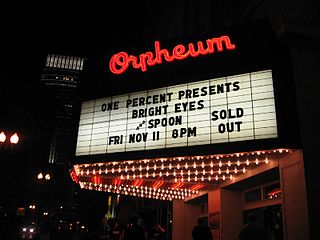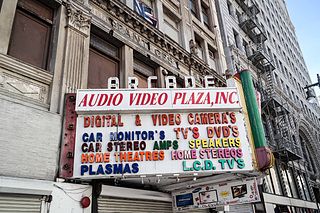Related Research Articles

The Fox Theatre is a performing arts center located at 2211 Woodward Avenue in Downtown Detroit, Michigan, near the Grand Circus Park Historic District. Opened in 1928 as a flagship movie palace in the Fox Theatres chain, it was at over 5,000 seats the largest theater in the city. Designed by theater architect C. Howard Crane, it was listed on the National Register of Historic Places in 1985.

The Palace Theatre is a Broadway theater at 1564 Broadway, at the north end of Times Square, in the Midtown Manhattan neighborhood of New York City. Designed by Milwaukee architects Kirchhoff & Rose, the theater was funded by Martin Beck and opened in 1913. From its opening to about 1929, the Palace was considered among vaudeville performers as the flagship venue of Benjamin Franklin Keith and Edward Franklin Albee II's organization. The theater had 1,648 seats across three levels as of 2018.

The Warner Grand Theatre is a historic movie palace that opened on January 20, 1931. It is located in San Pedro, Los Angeles, California, at 478 West 6th Street.

Benjamin Marcus Priteca was a Scottish architect. He is best known for designing theatres for Alexander Pantages.

The Pantages Theatre is a historic theatre in Minneapolis, Minnesota. The original building was a Beaux-Arts style twelve-story complex on Hennepin Avenue, designed by Kees & Colburn and operated by Alexander Pantages, a Greek immigrant who opened 500 theatres.

The Orpheum Theatre is a historic theater located in downtown Minneapolis, Minnesota. It is one of four restored theaters on Hennepin Avenue, along with the State Theatre, the Pantages Theatre, and the Shubert Theatre.

Hollywood Pantages Theatre, formerly known as RKO Pantages Theatre and Fox-Pantages Theatre, also known as The Pantages, is a live theater and former movie theater located at 6233 Hollywood Boulevard, near Hollywood and Vine, in the Hollywood neighborhood of Los Angeles, California. Designed by architect B. Marcus Priteca, the theater was the last built by the vaudeville impresario Alexander Pantages and also the last movie palace built in Hollywood.

An atmospheric theatre is a type of movie palace design which was popular in the late 1920s. Atmospheric theatres were designed and decorated to evoke the feeling of a particular time and place for patrons, through the use of projectors, architectural elements and ornamentation that evoked a sense of being outdoors. This was intended to make the patron a more active participant in the setting.

The Mainstreet Theater, also commonly referred to as The Empire Theater, is a historic theater in downtown Kansas City, Missouri in the Power & Light District. The theater was landmarked and placed on the National Register of Historic Places in February 2007.

The Orpheum Theater is a theater located in Omaha, Nebraska. The theater hosts programs best served by a more theatrical setting, including the Omaha Performing Arts Broadway Season, presented with Broadway Across America, and Opera Omaha's season. The theatre is listed on the National Register of Historic Places. The main auditorium is a proscenium theater known as "Slosburg Hall". The theater has a theatre organ, made by Wurlitzer.

The Broadway Theater District in the Historic Core of Downtown Los Angeles is the first and largest historic theater district listed on the National Register of Historic Places (NRHP). With twelve movie palaces located along a six-block stretch of Broadway, it is the only large concentration of movie palaces left in the United States. The same six-block stretch of Broadway, and an adjacent section of Seventh Street, was also the city's retail hub for the first half of the twentieth century, lined with large and small department stores and specialty stores.

The Orpheum Theatre is a historic theater in downtown Wichita, Kansas, United States. It was designed by renowned theatre architect John Eberson with funding from a group of local investors and opened on September 4, 1922.
Broadway Across America (BAA) is a presenter and producer of live theatrical events in the United States and Canada since 1982. It is currently owned by the John Gore Organization, which purchased it from Live Nation in 2008.

The Arcade Theatre is a historic former vaudeville and movie theater in the Broadway district of Los Angeles, California. Commissioned by real estate developer William May Garland in 1910, it originally operated under the direction of Alexander Pantages. In 1920, the Pantages operation moved to a new auditorium on 7th Street; thereafter, the theater became known as Dalton's Broadway for two years before ultimately taking the Arcade name in 1924 in association with the adjacent Spring Arcade building. Metropolitan Theatres later operated the facility as a grindhouse until its closure in 1992.

The Boston Opera House, also known as the Citizens Bank Opera House, is a performing arts and esports venue located at 539 Washington St. in Boston, Massachusetts. It was originally built as the B.F. Keith Memorial Theatre, a movie palace in the Keith-Albee chain. The chain became part of RKO when it was established just before the theater opened on October 29, 1928, and it was also known as the RKO Keith's Theater. After operating for more than 50 years as a movie theater, it was rededicated in 1980 as a home for the Opera Company of Boston, which performed there until the opera company closed down in 1990 due to financial problems. The theater was reopened in 2004 after a major restoration, and it currently serves as the home of the Boston Ballet and also hosts touring Broadway shows.

The Mississippi Lofts and Adler Theatre is an apartment building and theater complex located in downtown Davenport, Iowa, United States. It is individually listed on the National Register of Historic Places by its original name, the Hotel Mississippi and RKO Orpheum Theater. The Hotel Mississippi was listed on the Davenport Register of Historic Properties in 2005. In 2020 the complex was included as a contributing property in the Davenport Downtown Commercial Historic District.

The RKO Keith's Theater was an RKO Pictures movie theater at 135-35 Northern Boulevard in the Flushing neighborhood of Queens in New York City. It was designed by architect Thomas W. Lamb and built in 1928. While the RKO Keith's had a plain three-story facade, its interior was elaborately designed in a Spanish Baroque Revival style. The theater had a square ticket lobby and an oval grand foyer, which led to the double-level auditorium. The auditorium was designed as an atmospheric theater with a blue ceiling and gilded-plaster decorations; it contained 2,974 seats across two levels. There were also four lounges and a mezzanine promenade.

The Pantages Theatre or Jones Building in Tacoma, Washington was designed by the architect B. Marcus Priteca. The unusual structure opened in January 1918. However, the theatre was commissioned in 1916 by the theatre manager Alexander Pantages. It was designed to be an office building and a vaudeville theatre. The theater's Second Renaissance Revival style is juxtaposed with the Commercial style. The exterior above the ground floor is largely unaltered. The building still houses entertainment and commercial activities A brief overview of the owner and renovation history, in 1916–1918, B. Marcus Priteca with Edwin W. Houghton; 1955 remodel, Carlson, Eley, and Grevstad; 1982–1983 renovation, Richard F. McCann; 2006 entrance/lobby renovation, Korth Sunseri Hagey and Grulich Architecture and Planning; 2014 stage expansion and structural renovations, BCRA. 901 Broadway.

The historic Capitol Theatre was built at 50 West 200 South in Downtown Salt Lake City during 1913. Originally operated as a vaudeville house named Orpheum Theater, this was soon renamed Capitol Theater during 1927. And is currently also known as the JQ Lawson Capitol Theater. And this building style is Italian Renaissance and Mannerist architecture.

Erin Mendenhall is an American politician and activist who has been serving as the mayor of Salt Lake City, Utah since 2020. Upon taking office as Salt Lake City’s 36th mayor, Mendenhall became the city’s third and youngest woman in the role. Prior to assuming office, Mendenhall represented the city’s 5th district on the Salt Lake City Council.
References
- ↑ "Utah Theatre". UtahTheaters.info. Retrieved 2012-12-24.
- ↑ "With plans for a new downtown park, city moves closer to giving derelict Utah Theater to developers for demolition". The Salt Lake Tribune. Retrieved 2021-06-08.
- ↑ "Builders release details on the high-rise that will replace the Utah Theater". Building Salt Lake. 2021-01-12. Retrieved 2021-06-08.
- ↑ Porter, Christie (2021-04-09). "Is It Too Late to Stop Demolition of Historic Utah Theater? • Salt Lake Magazine". Salt Lake Magazine. Retrieved 2021-06-08.
- ↑ "Pantages Theatre Archive" . Retrieved 2021-06-08.
- ↑ "May Luncheon - Hines Development: The Utah Theater and The Square". Zoom Video. Retrieved 2021-06-09.
- ↑ "It's done. Salt Lake City closes its sale of the Utah Theater, makes way for new skyscraper". The Salt Lake Tribune. Retrieved 2021-11-14.
- ↑ "Preliminary demolition starts on Salt Lake City's Pantages Theater". Fox 13 News. April 19, 2022. Retrieved May 6, 2022.
- ↑ McKitrick, Cathy (2023-06-24). "The Aftermath of Hasty Destruction of Pantages Theater on Downtown Salt Lake Main Street". Utah Stories. Retrieved 2023-09-24.
- ↑ https://buildingsaltlake.com/a-year-after-demolishing-the-utah-theater-hines-is-set-to-miss-first-development-deadline/
- ↑ https://www.deseret.com/utah/2023/3/27/23658895/construction-main-street-tower-salt-lake-city/